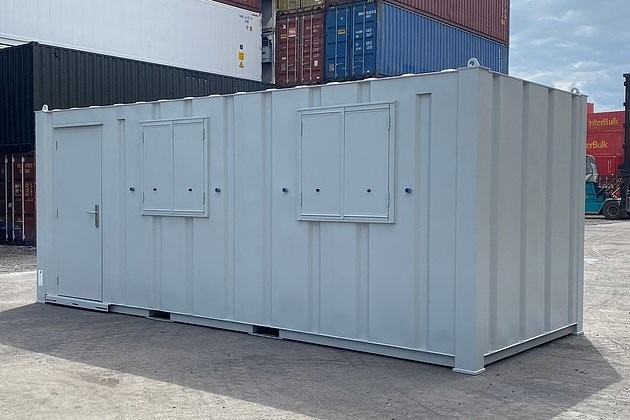Refrigerated containers, often referred to as "reefers," are a critical component of the global supply chain, particularly for the transportation of temperature-sensitive goods such as pharmaceuticals, perishable foods, and chemicals. These specialized shipping containers ensure that products remain in optimal condition during long journeys, whether by sea, road, or rail. This article delves into the intricate world of refrigerated containers, exploring their history, technology, applications, and the future of the industry.
History of Refrigerated Containers
The concept of refrigerated shipping dates back to the 19th century when ice was used to keep cargo cool during transit. However, the modern refrigerated container emerged in the mid-20th century with the advent of mechanical refrigeration. The first commercially successful reefers were introduced in the 1960s, revolutionizing the logistics of perishable goods. Today, refrigerated containers have become indispensable in the global trade of temperature-sensitive products, ensuring that items like fresh fruits, vegetables, and medical supplies reach their destinations in pristine condition.
Technology Behind Refrigerated Containers
Refrigerated containers are equipped with advanced cooling systems to maintain the desired temperature throughout the journey. The key components of a reefer include:
- Refrigeration Units: These are the heart of the container, responsible for maintaining the required temperature. Modern units use a variety of refrigerants, including eco-friendly options, to ensure efficient cooling.
- Thermometers and Sensors: These devices monitor the temperature inside the container and provide real-time data to the control systems.
- Control Panels: These panels allow operators to set and adjust temperature settings, humidity levels, and other environmental parameters.
- Insulation: High-quality insulation materials are used to prevent heat exchange between the container and the external environment, ensuring that the temperature remains stable.
- Ventilation Systems: Some reefers include ventilation systems to control air circulation and prevent the buildup of ethylene gas, which can accelerate the ripening of fruits and vegetables.
Types of Refrigerated Containers
Refrigerated containers come in various sizes and configurations to meet the diverse needs of different industries. Some of the most common types include:
- Standard Reefers: These are the most widely used refrigerated containers, available in 20-foot and 40-foot lengths. They are suitable for a wide range of temperature-sensitive goods.
- Controlled Atmosphere (CA) Reefers: These containers are designed to maintain specific levels of oxygen, carbon dioxide, and other gases to extend the shelf life of fruits and vegetables.
- Cryogenic Reefers: These containers use liquid nitrogen to achieve extremely low temperatures, making them ideal for transporting frozen goods and pharmaceuticals.
- Dual-Temperature Reefers: These containers have separate compartments that can be set to different temperatures, allowing for the simultaneous transport of both chilled and frozen goods.
- Insulated Dry Cargo Containers: While not actively cooled, these containers are insulated to prevent temperature fluctuations and are often used for short-distance transport of temperature-sensitive goods.
Applications of Refrigerated Containers
Refrigerated containers play a crucial role in various industries, ensuring the safe and efficient transport of a wide array of goods. Some of the key applications include:
- Food Industry: Refrigerated containers are essential for transporting fresh fruits, vegetables, meats, and dairy products. They help maintain the freshness and quality of these items, ensuring they are safe for consumption upon arrival.
- Pharmaceuticals: The pharmaceutical industry relies heavily on reefers to transport medications, vaccines, and other temperature-sensitive medical supplies. Proper temperature control is crucial to ensure the efficacy and safety of these products.
- Chemical Industry: Many chemicals require specific temperature conditions to prevent degradation or hazardous reactions. Reefers provide the necessary control to ensure safe transport.
- Flowers and Plants: Fresh cut flowers and plants are often transported in refrigerated containers to maintain their freshness and extend their shelf life.
- Electronics: Some electronic components and devices are sensitive to temperature variations and require controlled environments during transit to prevent damage.
Challenges in the Refrigerated Container Industry
While refrigerated containers have significantly improved the logistics of temperature-sensitive goods, the industry faces several challenges:
- Energy Efficiency: Refrigeration units consume a significant amount of energy, which can be a concern for both cost and environmental impact. Manufacturers are continuously working on developing more energy-efficient units.
- Maintenance and Repair: Reefers require regular maintenance and timely repairs to ensure they function correctly. Any failure in the refrigeration system can lead to the spoilage of the entire shipment.
- Temperature Monitoring: Ensuring that the temperature remains within the specified range throughout the journey is critical. Advanced monitoring systems and IoT technologies are being integrated to provide real-time data and alerts.
- Regulatory Compliance: The transportation of temperature-sensitive goods is subject to various regulations and standards. Compliance with these regulations is essential to avoid penalties and ensure the safety of the products.
Future of Refrigerated Containers
The future of refrigerated containers looks promising, with several advancements on the horizon:
- Sustainability: There is a growing focus on reducing the environmental impact of reefers. Eco-friendly refrigerants, solar-powered units, and energy-efficient designs are being developed to make refrigerated containers more sustainable.
- IoT and Smart Technology: The integration of IoT devices and smart technology is transforming the industry. These technologies enable real-time monitoring, predictive maintenance, and optimized energy usage.
- Automation: Automation in the loading and unloading of reefers can increase efficiency and reduce the risk of temperature fluctuations during handling.
- Capacity and Demand: As global trade continues to grow, the demand for refrigerated containers is expected to increase. This will drive the need for larger and more efficient containers.
FAQs About Refrigerated Containers
Q: What is the temperature range that a standard reefer can maintain?A: A standard refrigerated container can maintain temperatures ranging from -25°C to +25°C, making it suitable for a wide variety of goods.
Q: How long can a reefer operate without being plugged into a power source?A: Most refrigerated containers have built-in generators that can operate for several hours without external power. However, for longer journeys, they need to be connected to a power source, such as a ship’s power supply or a generator on the road.
Q: What is the difference between a refrigerated container and a freezer container?A: A refrigerated container is designed to maintain a range of temperatures, including both chilled and frozen conditions. A freezer container, on the other hand, is specifically designed to maintain very low temperatures, typically below -18°C, for transporting frozen goods.
Q: Are refrigerated containers used only for sea transport?A: No, refrigerated containers are used for multimodal transport, including sea, road, and rail. They are versatile and can be easily transferred between different modes of transportation.
Q: How are reefers loaded and unloaded?A: Reefers are typically loaded and unloaded using forklifts or specialized equipment. The loading and unloading process must be quick to minimize the time the container is open and to prevent temperature fluctuations.

Refrigerated containers have revolutionized the transportation of temperature-sensitive goods, ensuring that products remain in optimal condition during long journeys. From their early beginnings to the advanced technology of today, reefers continue to play a vital role in global trade. Despite the challenges, the future of refrigerated containers is bright, with ongoing innovations in sustainability, smart technology, and automation poised to enhance their efficiency and reliability. Whether transporting fresh produce, pharmaceuticals, or other sensitive goods, reefers are an essential part of the modern logistics landscape.
Key Points to Remember
- Refrigerated containers (reefers) are crucial for the transportation of temperature-sensitive goods.
- Advanced technology includes refrigeration units, thermometers, sensors, and control panels.
- Common types include standard reefers, controlled atmosphere (CA) reefers, cryogenic reefers, and insulated dry cargo containers.
- Key applications are in the food, pharmaceutical, chemical, and electronics industries.
- Challenges include energy efficiency, maintenance, temperature monitoring, and regulatory compliance.
- Future trends focus on sustainability, IoT integration, automation, and increased capacity.
By understanding the intricacies of refrigerated COG Containers LTD, businesses can better navigate the complex world of temperature-controlled logistics and ensure the safe and efficient transport of their valuable goods.








